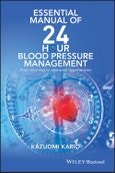Table of Contents
Author biography viii
Preface x
Acknowledgments xi
1 First focusing on “morning hypertension” 1
What is the “perfect 24-hour blood pressure control”? 1
Definition of “morning hypertension” 4
How to assess “morning hypertension” 5
Home BP monitoring 7
Ambulatory BP Monitoring 9
Feasibility of controlling morning hypertension 12
Subtypes of morning hypertension 14
2 Morning surge in blood pressure 15
Definition of MBPS 15
Cardiovascular events with MBPS 16
Organ damage with MBPS 19
Hypertensive heart disease 20
Vascular disease and inflammation 21
Silent cerebrovascular disease 22
Chronic kidney disease 24
Determinants of MBPS 25
Mechanism of morning risk 28
Hemostatic abnormality and MBPS 29
Vascular mechanism of exaggerated MBPS 31
3 Nocturnal hypertension 35
Circadian rhythm of BP 35
Non-dipper/risers of nocturnal BP 35
Definition and risk of nocturnal hypertension 38
Mechanism of nocturnal hypertension 43
Associated conditions 44
Diabetes 45
Chronic kidney disease 47
Sleep apnea syndrome 48
Extreme dipper - another type of disrupted circadian BP rhythm 48
4 What is systemic hemodynamic atherothrombotic syndrome? 50
A typical case of SHATS 50
Clinical relevance of SHATS 52
Pathological target of SHATS 54
Mechanism of vicious cycle of SHATS 57
5 Home blood pressure variability 61
Maximum home SBP 61
SD of morning SBP 62
Morning orthostatic hypertension 64
6 Development of information technology-based new home blood pressure variability monitoring system 67
Disaster cardiovascular prevention network 67
Cutting-edge of HBPM 71
Basic nocturnal BP monitoring at home (Medinote) 71
“Thermosensitive hypertension” detecting home BP device 74
Trigger nocturnal BP monitoring 75
IT-based trigger nocturnal pressure monitoring system 81
Detection and management of OSAS using new IHOPE-TNP 82
7 Home blood-pressure-monitoring guided morning hypertension control 88
Non-specific treatment 88
Specific treatment 89
8 Blood-pressure-lowering characteristics of antihypertensive drugs 91
Diuretics 91
Calcium channel blockers 91
Amlodipine 92
Nifedipine 94
Cilnidipine 95
Azelnidipine 96
Angiotensin-converting enzyme inhibitors 96
Angiotensin-receptor blockers 98
Telmisartan 98
Candesartan 98
Olmesartan 99
Azilsartan 103
Alpha-adrenergic blockers and beta-adrenergic blockers 104
RAS inhibitor-based combination 106
9 Home and ambulatory blood-pressure-profile-based combination strategy 109
First-line therapy 109
Second-line therapy 109
Arterial stiffness type 109
Volume retention type 110
Third-line therapy 110
10 Management of resistant hypertension 111
Evaluation of resistant hypertension 111
Fourth-line therapy 111
Circadian medication 114
11 Era of renal denervation 115
Evidence of renal denervation 115
Hypothesis of “perfect 24-hour BP control” by renal denervation 116
12 Latest evidence of controlling morning hypertension: the HONEST study 118
Conclusion and perspectives 122
References 123
Index 135








